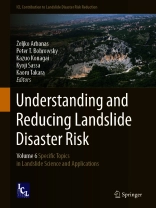This book is a part of ICL new book series “ICL Contribution to Landslide Disaster Risk Reduction” founded in 2019. Peer-reviewed papers submitted to the Fifth World Landslide Forum were published in six volumes of this book series. This book contains the following parts:
• Impact of Large Ground Deformations near Seismic Faults on Critically Important Civil Infrastructures
• Recent Progress in the Landslide Initiating Science
• Earth Observation and Machine Learning in Landslide Science
• General Landslide Studies
Professor Željko Arbanas is the Vice President of International Consortium on Landslides. He is a Professor of Faculty of Civil Engineering, University of Rijeka, Croatia. He is the Assistant Editor-in-Chief of International Journal Landslides.
Professor Peter Bobrowsky is the President of International Consortium on Landslides. He is a Senior Scientist of Geological Survey of Canada, Ottawa, Canada.
Professor Kazuo Konagai is Professor Emeritus at the University of Tokyo and Principal Researcher at the ICL Headquarters. He serves as the Secretary-General of the Fifth World Landslide Forum.
Professor Kyoji Sassa is the Founding President and the Secretary-General of the International Consortium on Landslides (ICL). He has been the Editor-in-Chief of International Journal Landslides since its foundation in 2004.
Professor Kaoru Takara is the Executive Director of International Consortium on Landslides. He is a Professor and Dean of Graduate School of Advanced Integrated Studies (GSAIS) in Human Survivability (Shishu-Kan), Kyoto University.
Table of Content
Impact of large ground deformations near seismic faults on critically important civil-infrastructures, Recent earthquakes that hit areas covered and/or underlain by pyroclastic matters and their impacts on lifelines.- Landslides in recent earthquakes and damage to lifelines.- Lessons Learned – Landslide Induced Lifelines Disasters from Past Earthquakes.- Lessons from recent geo-disasters in Hokkaido under earthquake.- Relation between horizontal direction of crustal deformation surveyed on the control points and area ratio of the slope failures triggered by the 2016 Kumamoto earthquake (Mj7.3).- Seismic response of buried pipeline to strong ground motion of strike-slip fault.- Reconstruction Strategies for Mw 7.8 Earthquake-induced Landslide-affected Settlements in Nepal.- State of nuclear power plant risk assessment for ground deformation with seismic faulting.- Relationship between Arias intensity and the earthquake-induced displacements of slopes.- Recent Progress inthe Landslide Initiating Science, Water exfiltration from bedrock: an effective landslide triggering mechanism.- Controls on landslide size: insights from field survey data.- Mechanism of slope disaster caused by extreme rain-fall in Izu Oshima Island, Japan, and future safety judgement.- Lessons from recent geo-disasters in Hokkaido under heavy rainfall.- Lessons from Geo-disasters caused by heavy rainfall in recent years in Kyushu Island, Japan.- An empirical method for estimating debris-flow volume in the Wenchuan earthquake area, Sichuan Province, China.- Investigation of internal erosion of wide grading loose soil – a micromechanics-based study.- Formation Mechanism and Stability of The Instable Block Formed in Xinmo Landsilde.- Landslide Field Experiment on a Natural Slope in Futtsu City, Chiba Prefecture.- Mechanism of landslide initiation in small-scale sandy slope triggered by an artificial rain.- Experimental study on formation and propagation of debris flow triggered by the glacial lake outburst flood.- Quantitative analysis of landslide processes based on seismic signals – a new method for monitoring and early warning of landslide hazards.- Earth Observation and Machine Learning, High-resolution point-cloud for Landslides in the 21st Century: from data acquisition to new processing concepts.- Detecting change of patterns in landslide displacements using machine learning, an example application.- Predicting rainfall induced slope stability using Random Forest regression and synthetic data.- Automatized dissemination of landslide monitoring bulletins for early warning applications.- General Landslide Studies, Engineering geological appreciation in landslide mapping for a natural gas pipeline project: challenges and risk reduction measures.- Loess Stratigraphy and Loess Landslides in the Chinese Loess Plateau.- The Jettan Rockslide- an engineering geological overview.- Mapping, hazard and consequence analyses for unstable rock slopes in Norway.-Landscape development and large rock slope instabilities in Manndalen, northern Norway.- Disaster Risk Assessment of the Silk Road.- Analysis of the Characteristics of Glacial Debris Flow Activity in Parlung Tsangpo Basin, Tibet.- Rehabilitation of gully-dominant hill slopes by using low-cost measures-a case study in Nepal.- Site Suitability Analysis for Nature-based Landslide Risk Mitigation.- Study on the Application of Nature Based Landslide Mitigation in Sri Lanka.- Slope stability around the northern part of the Tegucigalpa Basin, Honduras: A case of landslide process at residential development areas.- Classification of Cryogenic Landslides and Related Phenomena (by Example of the Territory of Russia).- Cutting-edge technologies aiming for better outcomes of landslide disaster mitigation.
Language English ● Format PDF ● Pages 407 ● ISBN 9783030607135 ● File size 61.4 MB ● Editor Željko Arbanas & Peter T. Bobrowsky ● Publisher Springer International Publishing ● City Cham ● Country CH ● Published 2020 ● Downloadable 24 months ● Currency EUR ● ID 7720406 ● Copy protection Social DRM












